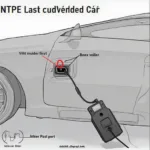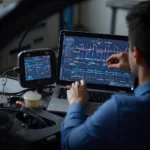OBD2 MIL codes, also known as check engine lights, can be a source of frustration for car owners. This guide will delve into everything you need to know about these diagnostic trouble codes, from what they are and why they appear to how to interpret and address them.
What are OBD2 MIL Codes?
OBD2, or On-Board Diagnostics II, is a standardized system that allows external electronics to interface with a vehicle’s computer system to diagnose issues. The MIL, or Malfunction Indicator Lamp (often referred to as the check engine light), illuminates when the OBD2 system detects a problem that could potentially affect emissions or the vehicle’s performance. These problems are represented by specific alphanumeric codes, the OBD2 MIL codes.
Why Does My MIL Turn On?
A illuminated MIL can be triggered by a wide range of issues, from minor problems like a loose gas cap to more serious engine or transmission malfunctions. Understanding the potential causes can help you prioritize repairs. For example, a loose gas cap can cause evaporative emissions issues, triggering a specific OBD2 MIL code. Ignoring this seemingly minor issue can eventually lead to more serious problems. codigo mil obd2
Common Causes of OBD2 MIL Codes
- Faulty Oxygen Sensors: These sensors monitor the oxygen levels in the exhaust gases, crucial for maintaining proper fuel efficiency and emissions control.
- Damaged Catalytic Converter: The catalytic converter reduces harmful pollutants in exhaust gases. A failing converter can significantly impact vehicle emissions.
- Malfunctioning Mass Airflow Sensor (MAF): The MAF sensor measures the amount of air entering the engine, which is essential for calculating the correct fuel-air mixture.
- Faulty Spark Plugs or Ignition Coils: These components ignite the fuel-air mixture in the engine cylinders. Issues with these can lead to misfires and reduced performance.
- Emissions System Problems: This can include issues with the evaporative emissions system (EVAP), exhaust gas recirculation (EGR) system, or other emissions-related components. vehicle has mil but no codes obd2
How to Read OBD2 MIL Codes
Reading OBD2 MIL codes requires an OBD2 scanner. These scanners plug into the OBD2 port, usually located under the dashboard on the driver’s side. Once connected, the scanner can retrieve and display the stored codes.
Understanding the Code Structure
OBD2 MIL codes consist of a single letter followed by four numbers. The letter indicates the system affected (e.g., P for Powertrain, B for Body, C for Chassis, U for Network). The numbers further specify the nature of the problem.
“A thorough understanding of OBD2 codes empowers car owners to take proactive steps in vehicle maintenance,” says automotive expert, David Miller, ASE Certified Master Technician.
What to Do When Your MIL Light Turns On
- Don’t Panic: While a glowing MIL can be concerning, it doesn’t always indicate an immediate emergency.
- Read the Codes: Use an OBD2 scanner to retrieve the specific codes.
- Research the Codes: Look up the meaning of the codes online or in a repair manual. OBDFree offers comprehensive resources on OBD2 codes.
- Address the Problem: Depending on the severity and your mechanical skills, you can attempt to fix the issue yourself or take your vehicle to a qualified mechanic. obd2 onl reads mil status on codes
- Clear the Codes: After the repair, use the OBD2 scanner to clear the codes and ensure the MIL light turns off. how many miles should it take to reset obd2 codes
“Regularly checking and addressing OBD2 MIL codes can help prevent costly repairs down the road,” advises Sarah Chen, automotive engineer and consultant.
Conclusion
Understanding obd2 mil codes is crucial for every car owner. By utilizing the information and resources available, such as those provided by OBDFree, you can take control of your vehicle’s maintenance and address potential problems efficiently. Regularly checking your OBD2 system and addressing any issues promptly can save you time, money, and unnecessary stress in the long run. disabling abs light using obd2
FAQ
- What does OBD2 stand for? (On-Board Diagnostics II)
- What is a MIL code? (Malfunction Indicator Lamp code, representing a diagnostic trouble code)
- Where is the OBD2 port located? (Usually under the dashboard on the driver’s side)
- Do I need an OBD2 scanner? (Yes, to read and clear OBD2 codes)
- What should I do if my MIL light stays on after a repair? (Recheck the repair and potentially consult a mechanic)
- Can I drive with the MIL light on? (It depends on the code; some indicate serious issues requiring immediate attention)
- How often should I check my OBD2 system? (Regularly, especially if you notice any performance issues)
Need further assistance? Contact us via WhatsApp: +1(641)206-8880, Email: [email protected] or visit our office at 789 Elm Street, San Francisco, CA 94102, USA. Our 24/7 customer support team is ready to help.

